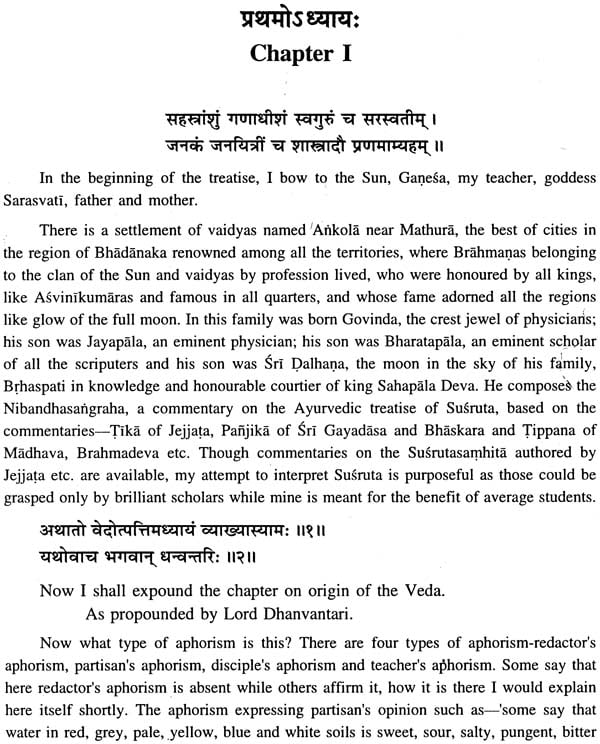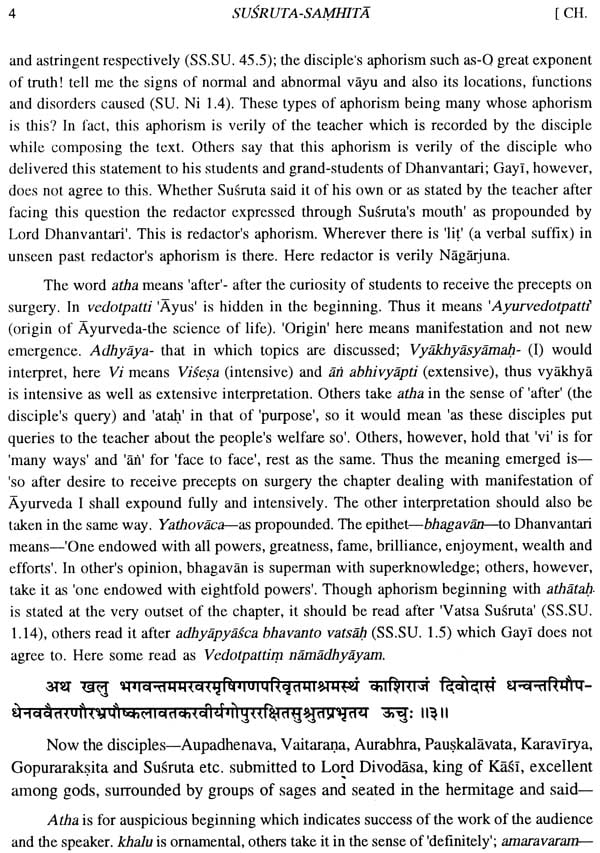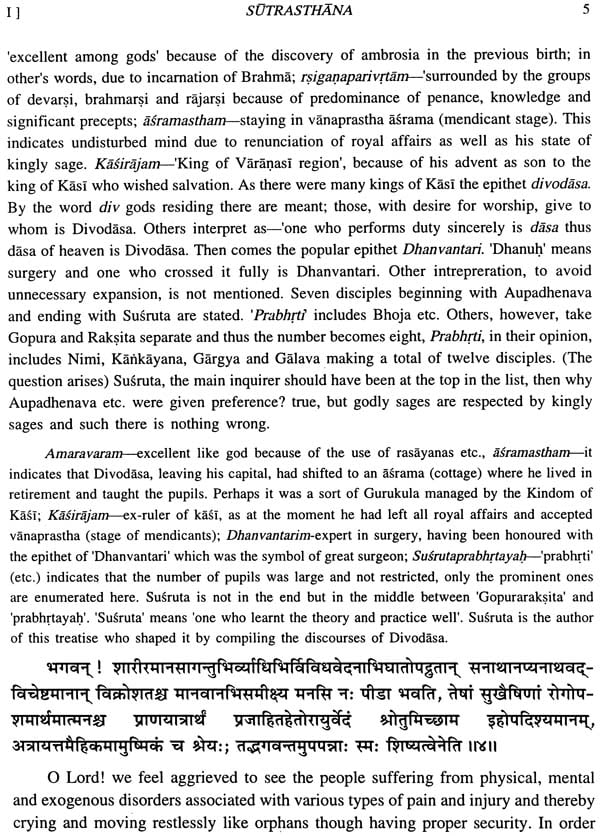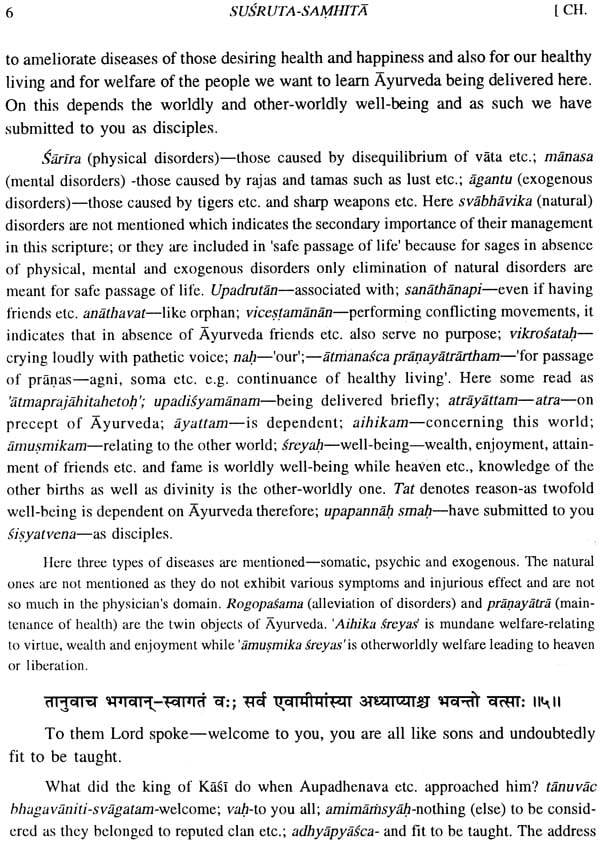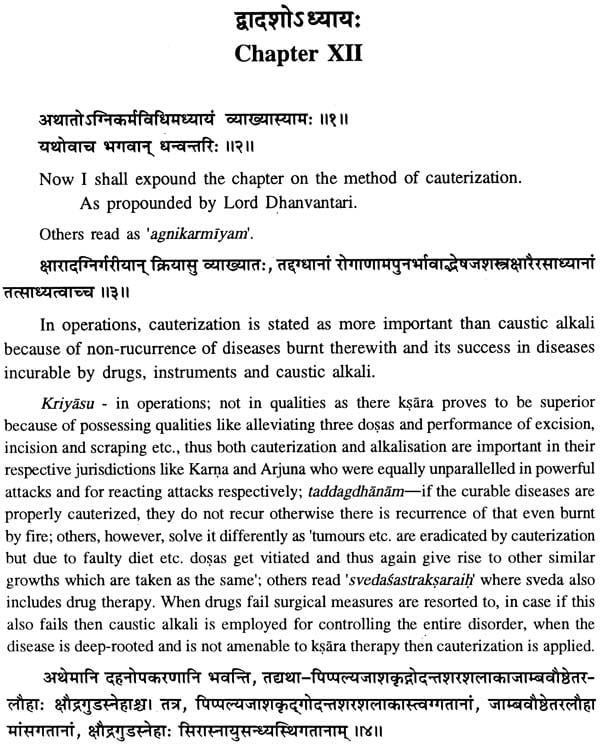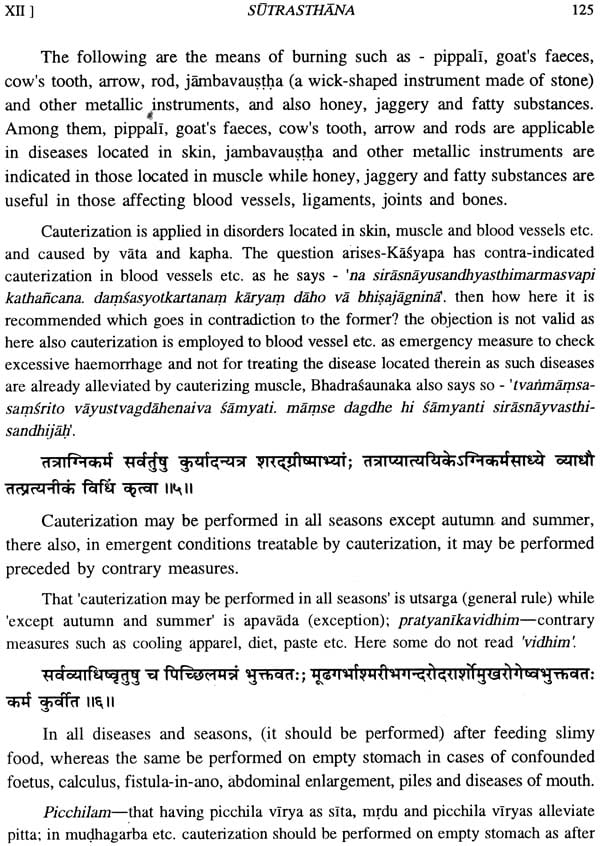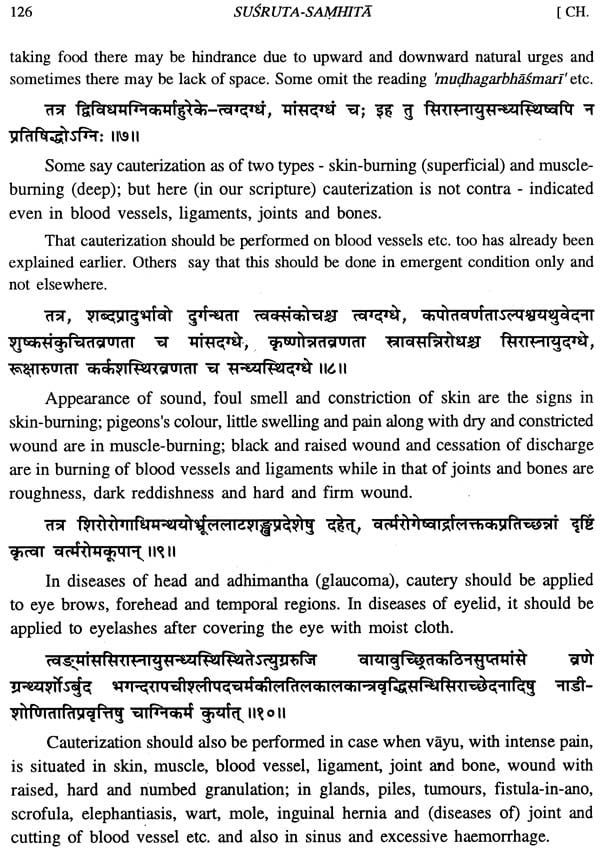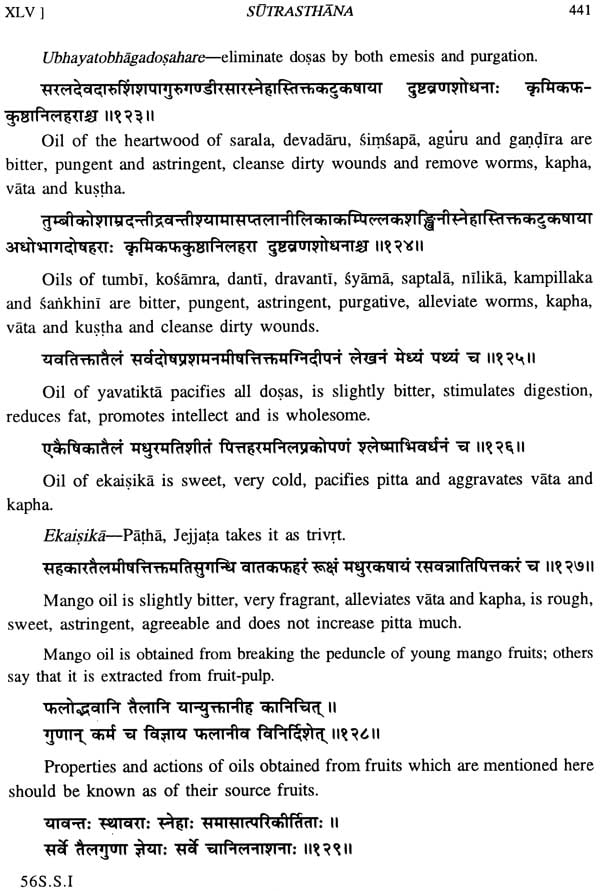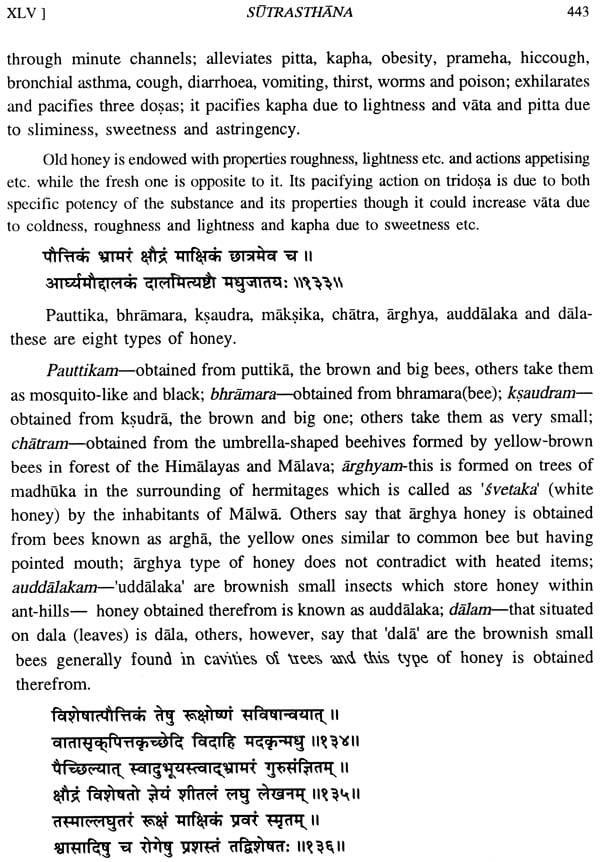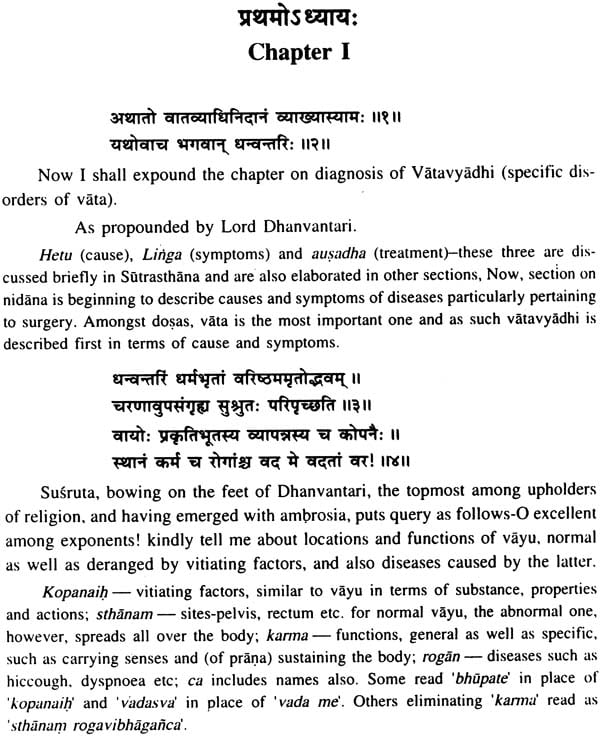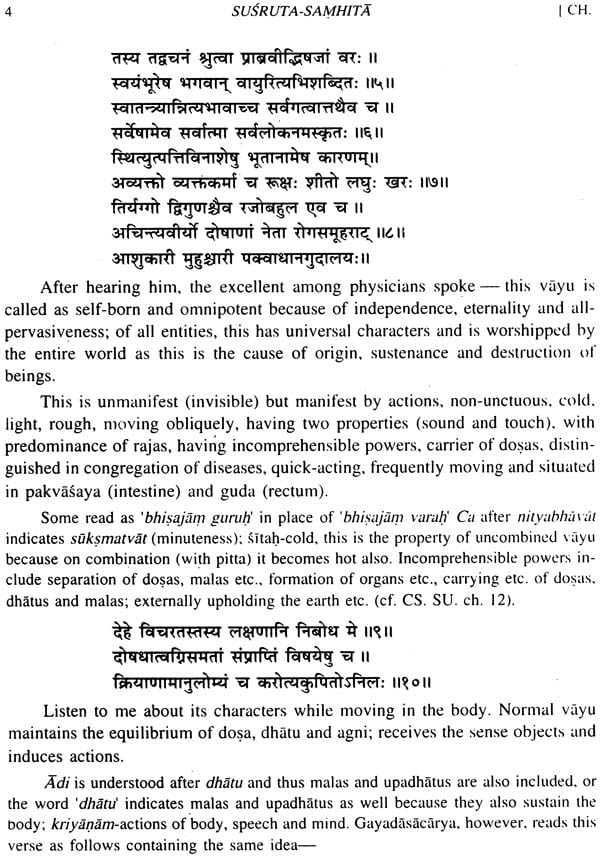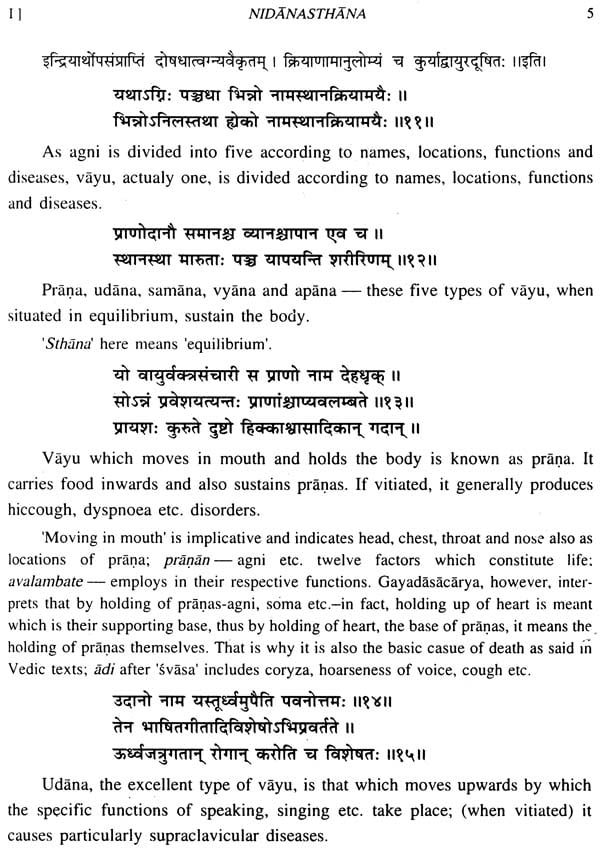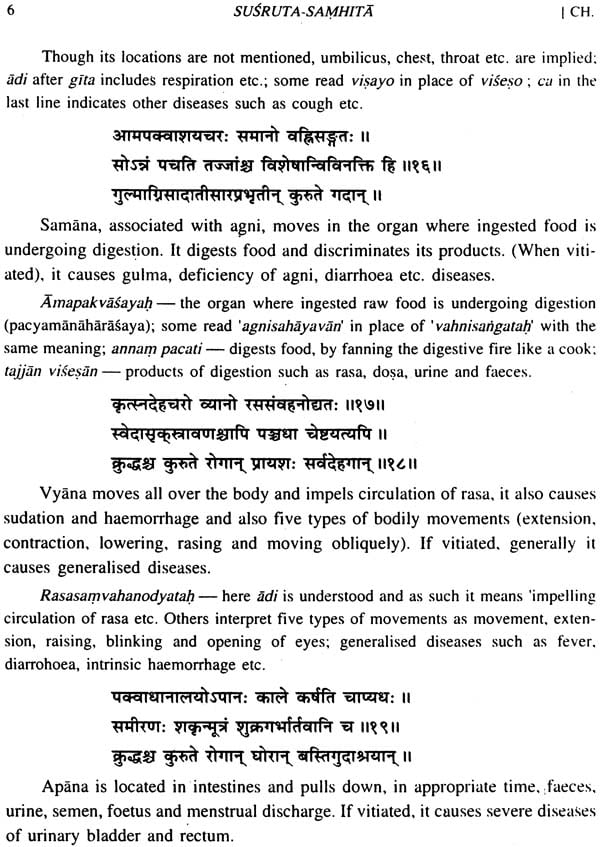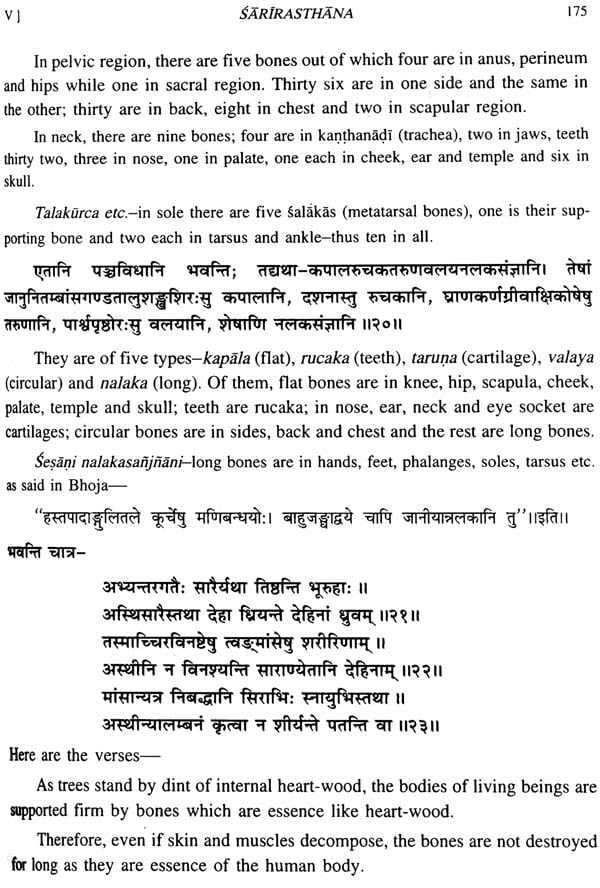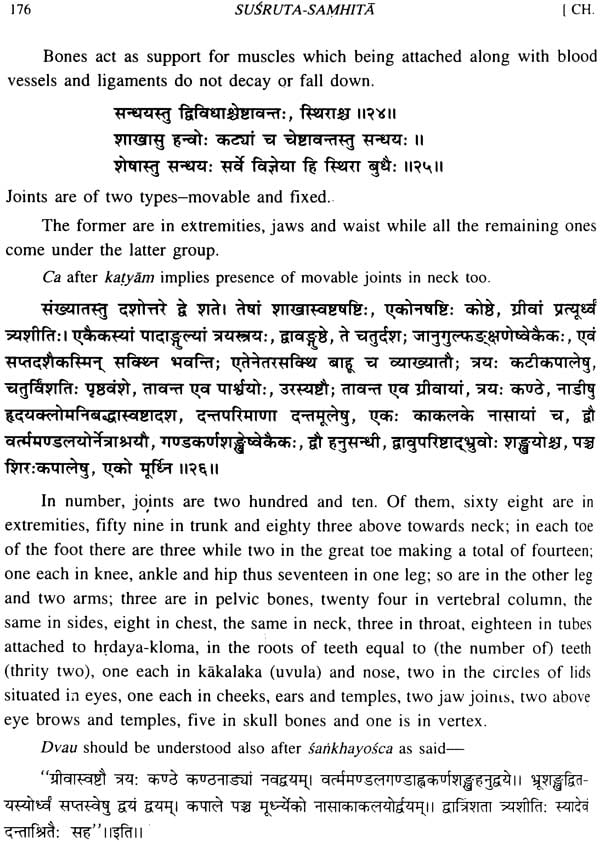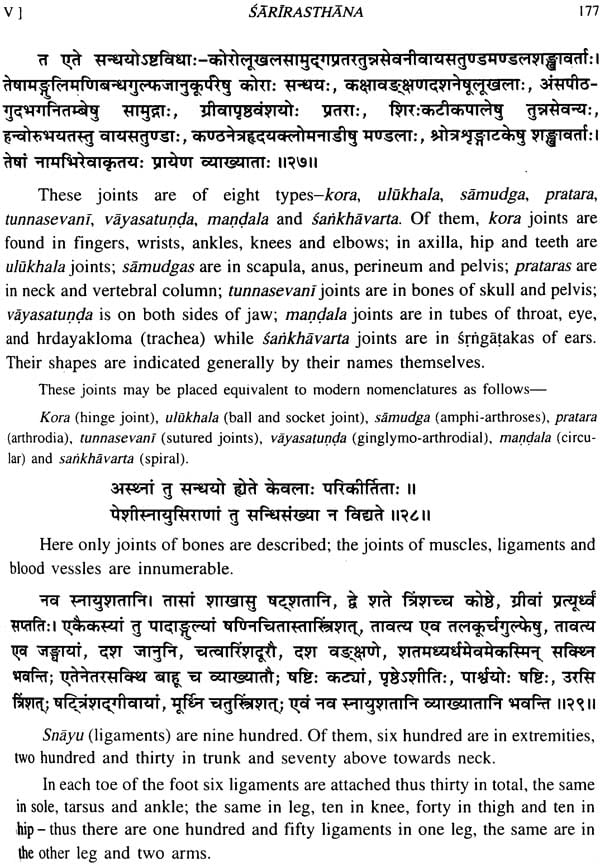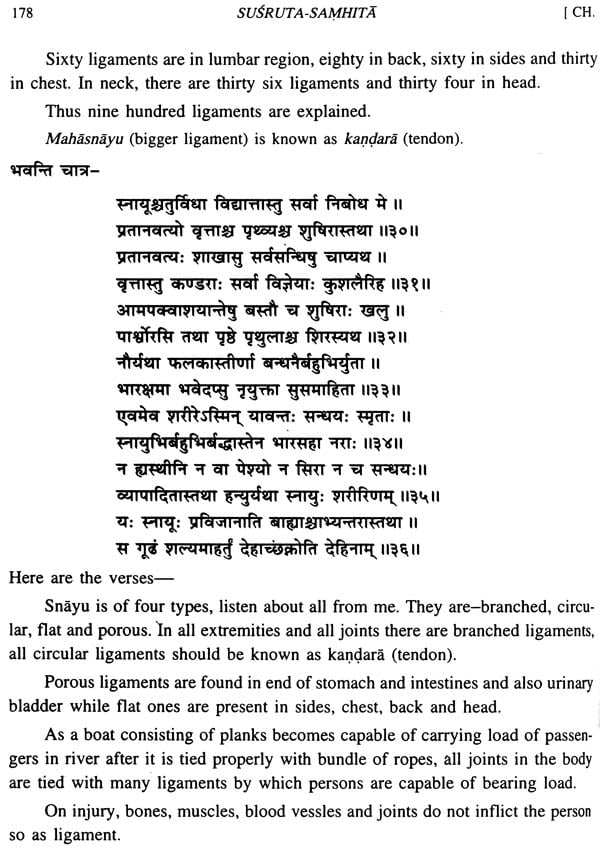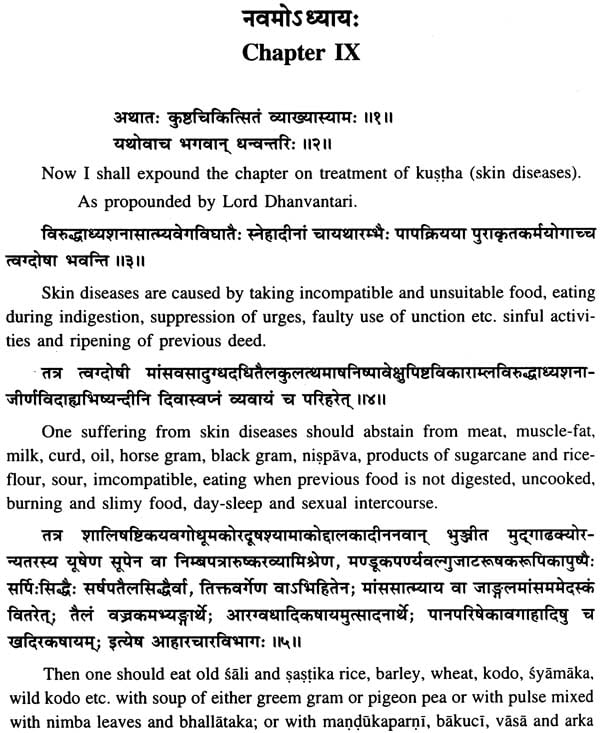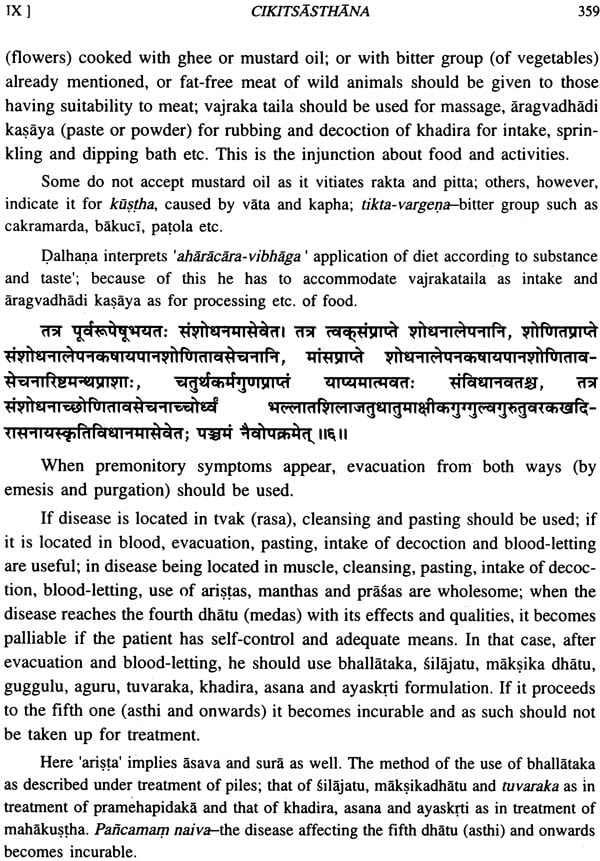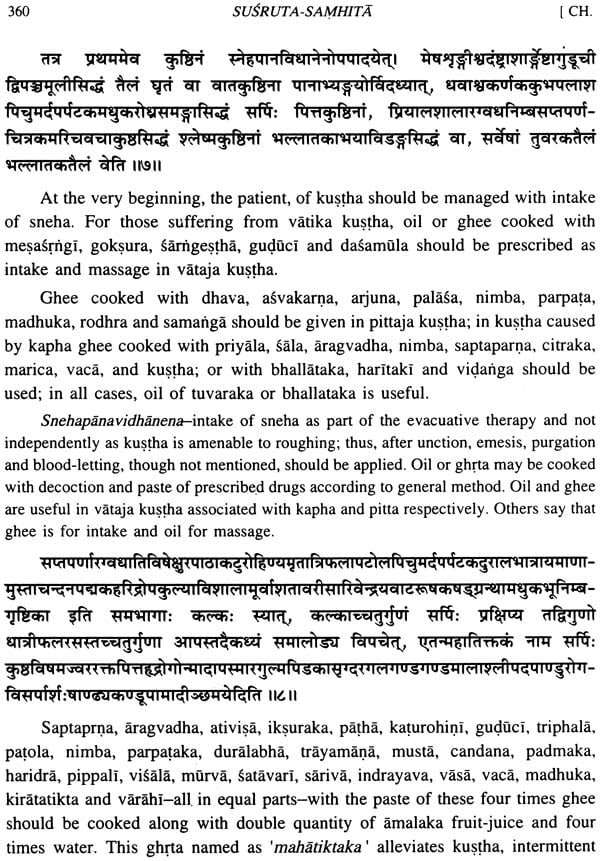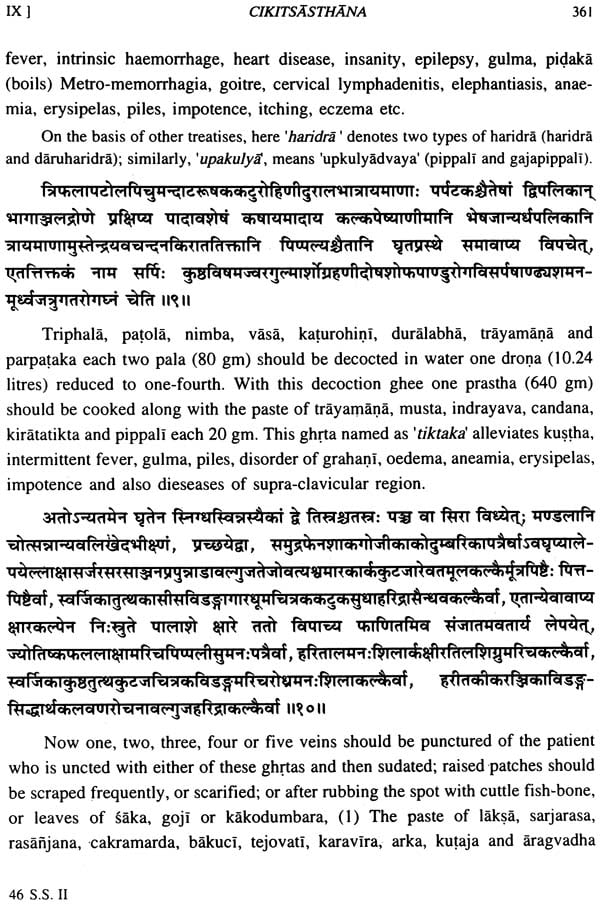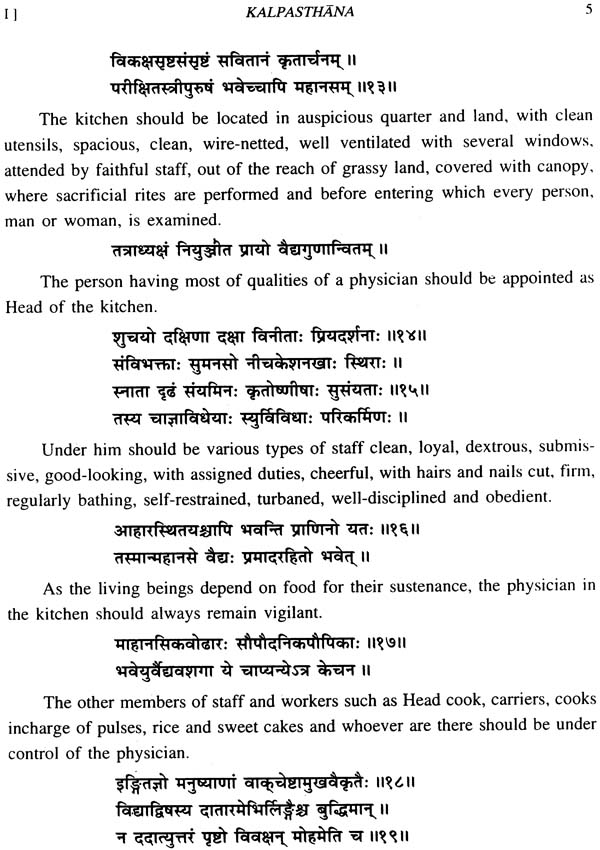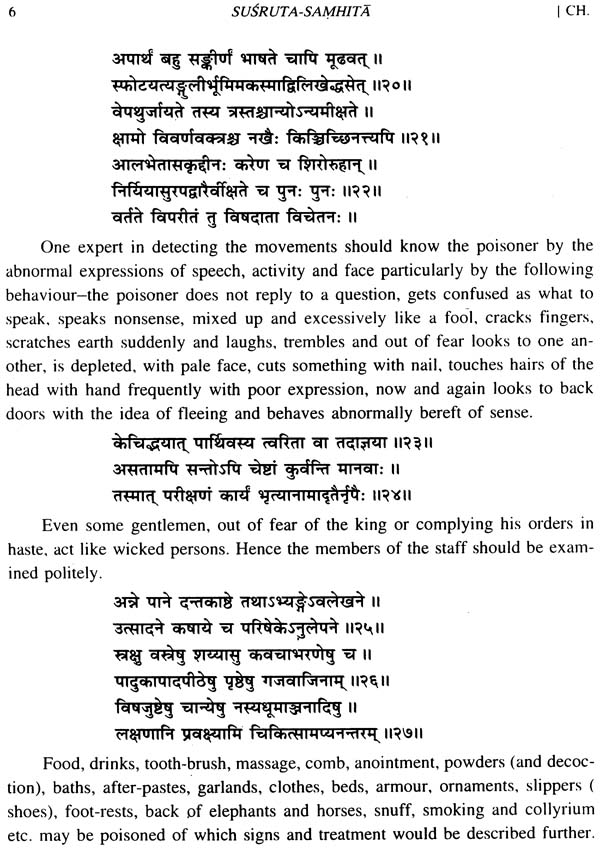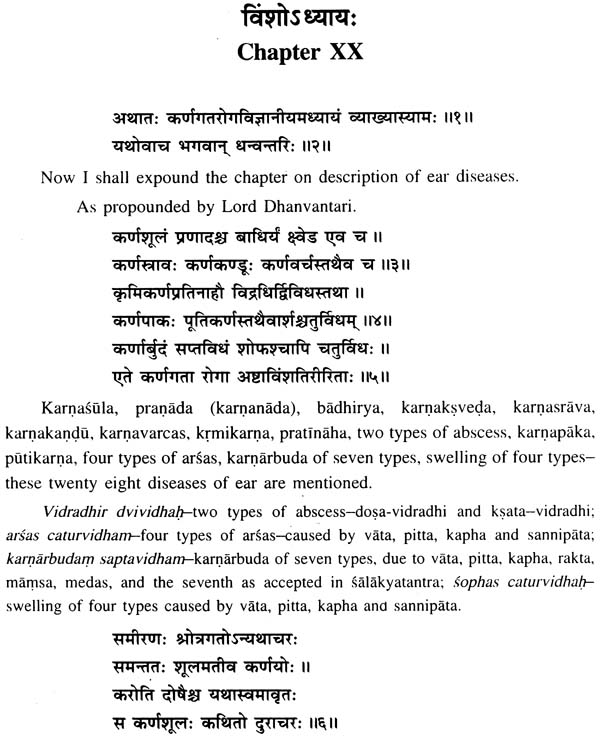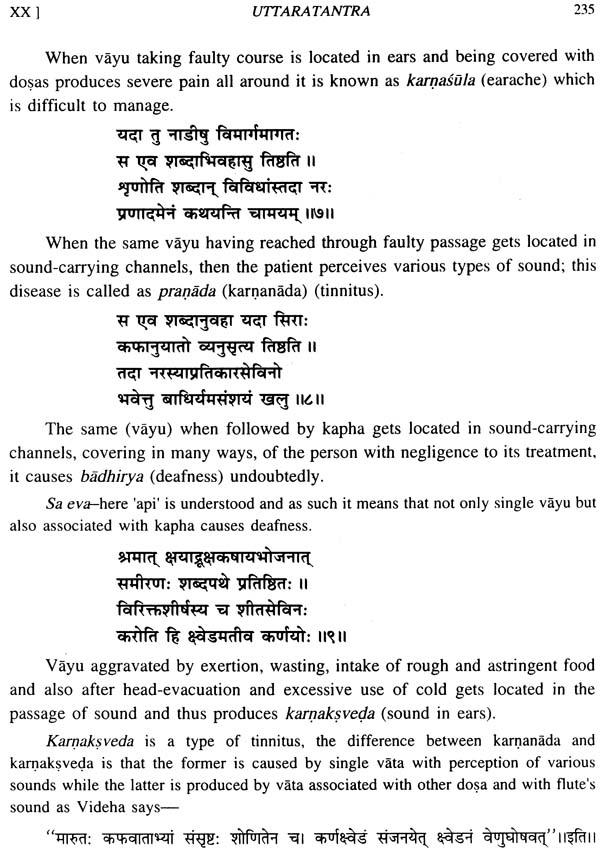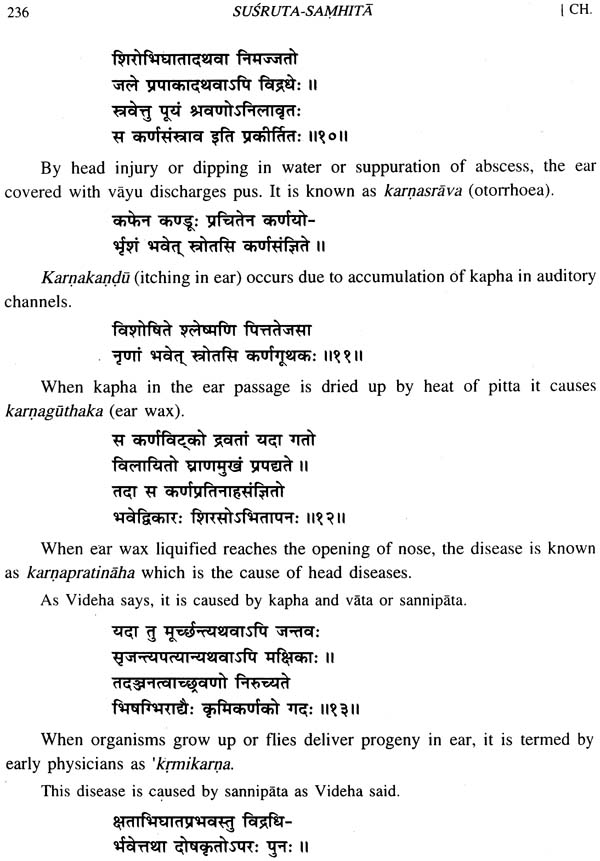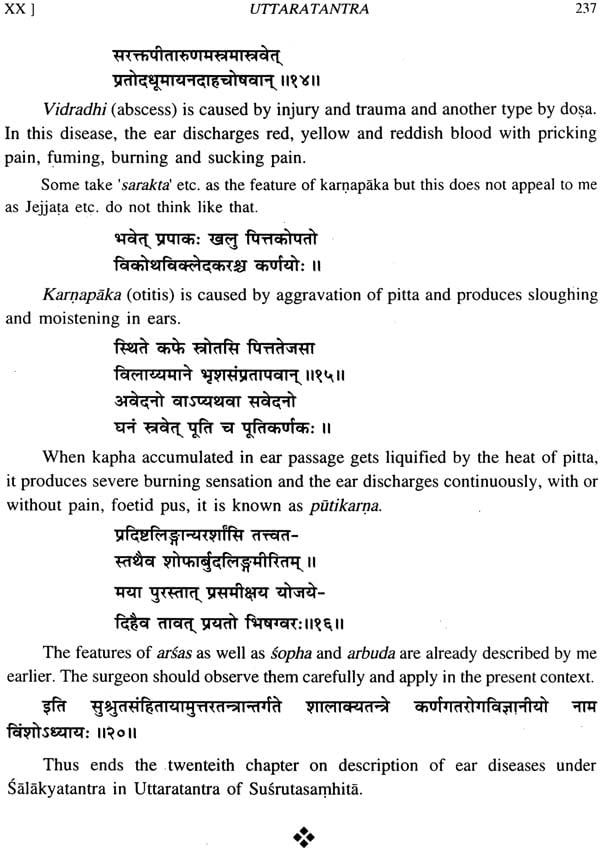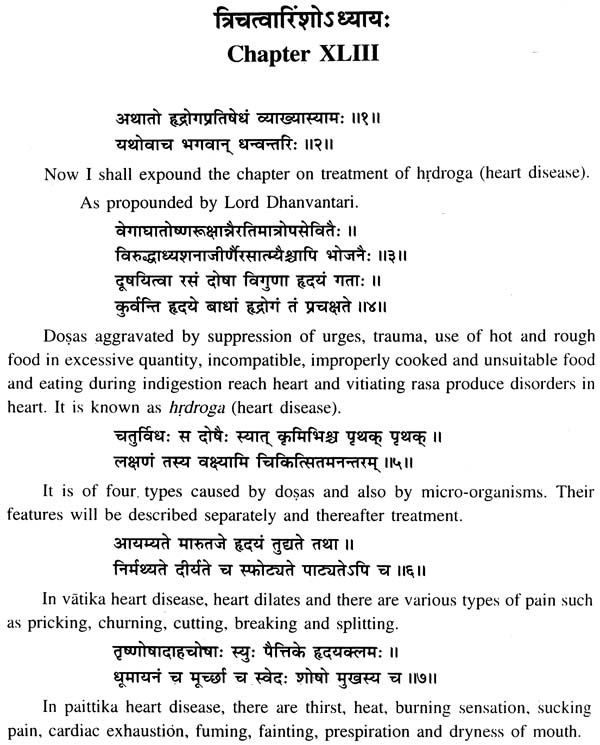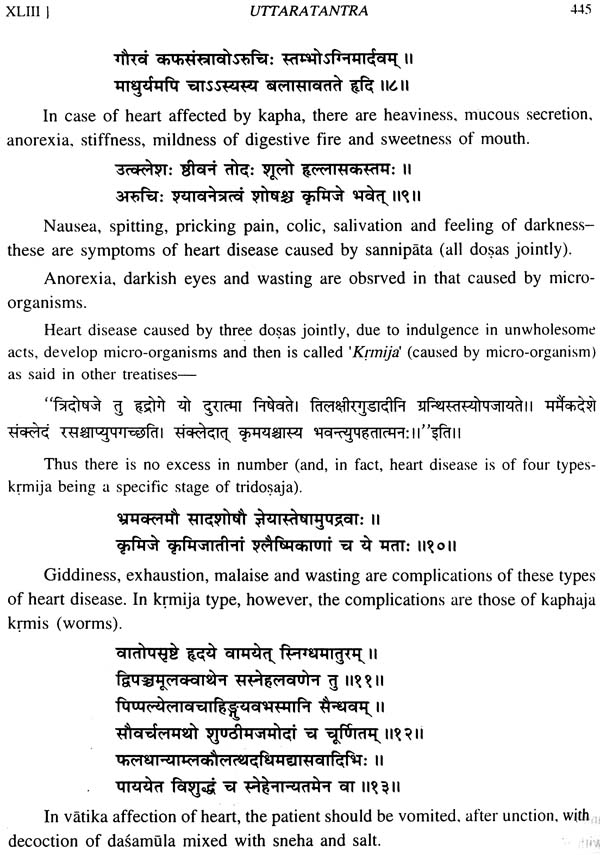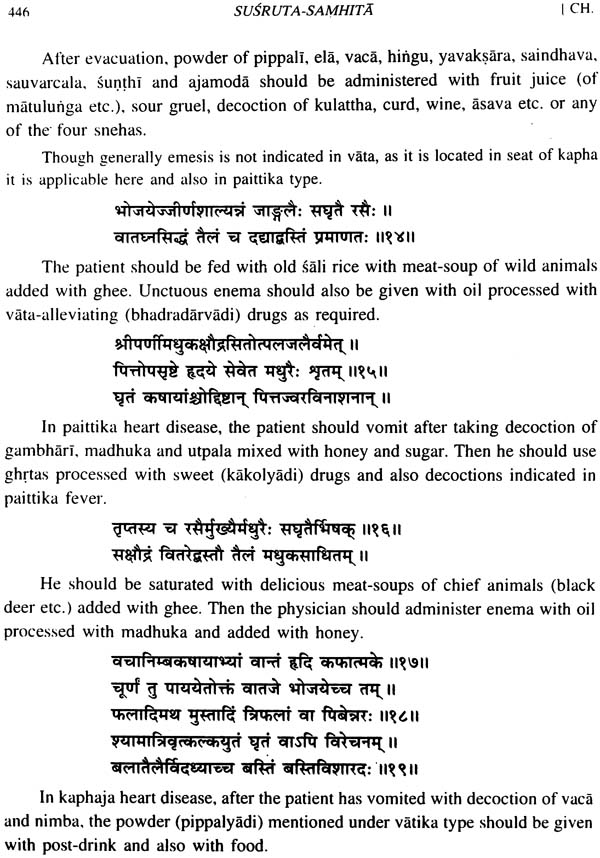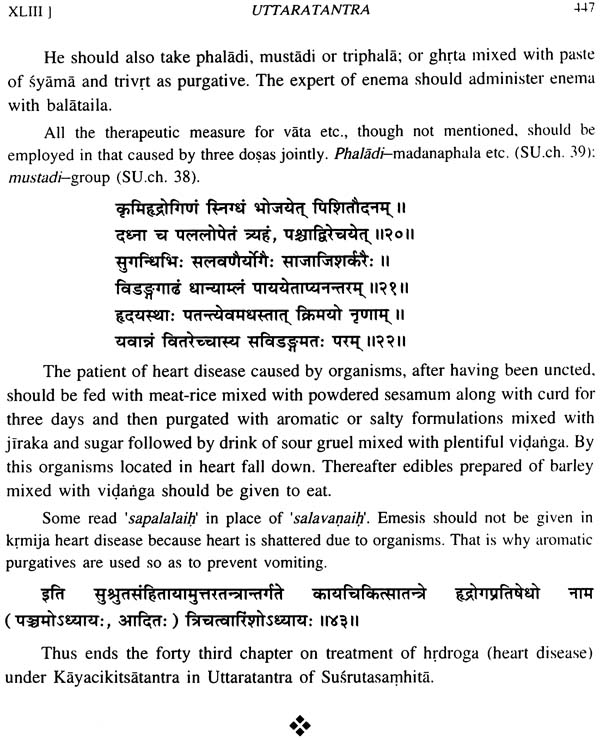
Susruta-Samhita with Dalhana's Commentary along with Critical Notes (Three Volumes)
Book Specification
| Item Code: | IDK022 |
| Author: | P.V. Sharma |
| Publisher: | Chaukhambha Visvabharati , Varanasi |
| Language: | English Translation of Text and |
| Edition: | 2014 |
| ISBN: | 9789381301258 |
| Pages: | 1982 |
| Cover: | Hardcover |
| Other Details | 9.6" X 7.2" |
| Weight | 3.48 kg |
Book Description
About the book
The Susruta-samhita is one of the twin compendia of Ayurveda encompassing all the aspects prevalent traditionally in India and abroad since the earliest times. It represents faithfully the school of surgery which made significant contributions to principles and techniques of surgery, which are surprisingly applicable even in modern era. It presents the status of ancient Indian surgery comprehensively and as such is in great demand among scholars all over the world.
The present edition of the Susruta-samhita is singular in the sense that, besides presenting faithful translation of the text, it brings forth, for the first time; it brings forth, for the first time, the English translation of the Nibandha-sangraha commentary by Dalhana who is regarded as the authority on the subject. The commentary supplements the text in many respects and as such proves an essential tool for understanding the samhita clearly and fully. Notes are also given here and there to elaborate the ideas with critical analysis. The text has also been checked and modified according to the readings accepted by Dalhana. Plants and other substances are also identified as interpreted by Dalhana. At the end of the text appendices are given which are very useful.
About the Author
Prof. P.V. Sharma is well known for his valuable contributions in the field of Ayurveda. During the last five decades he has written on various aspects of Ayurveda literary as well as scientific, conceptual as well as historical.
Born on 1st November 1920, in a small village near Patna, in the family of traditional vaidyas he gradually acquired highest degrees in Ayurveda, Sanskrit and Hindi and held highest posts in academic and administrative fields. In Bihar, he was, for many years, Principal Govt. Ayurvedic College, Patna and Dy. Director of Health Services (I.M.). Finally, he was appointed as Professor of Dravyaguna, also as Head, and later Director of the Postgraduate Institute of Indian Medicine, also Dean of the Faculty of Indian Medicine in Banaras Hindu University. He retired in 1980.
Prof. Sharma has been participating in international conferences abroad and has been associated with several committees on Ayurveda on national level. He has authored about 50 books and has about 500 published papers to his credit.
Introduction
The Susrut-samhita is the representative treatise of the Indian school of surgery (Salyatantra) popularly known as 'dhanvantara sampradaya'. Dhanvantara is so called as it was founded by Dhanvntari who was the symbol of surgical expertise. Initially 'Dhanvantari' was the name of the founder of the school but later on became epithet of clinicians who were experts in surgery. Dalhana, in his commentary, presenting etymological derivation of the word 'Dhanvantari' say - one who has acquired full knowledge of surgery is known as 'Dhanvantari'. The practitioner of the school of medicine generally referred the cases requiring surgical interference to these dhanvantariyas who were proficient in surgical operations including application of cautery, caustic alkali and bloodletting. In the treatment of gulma caraka was mentioned twice the jurisdiction of dhanvantariyas to such cases. Under the treatment of piles, he refers the surgeons by 'eke' and avoids surgical interference therein because of requiring perfect skill and possible risks. As kayacikitsa (general medicine) is the main subject in the Caraka-samhita, Salya (surgery) is the chief one in the Susruta-samhita though it contains other subjects as well.
In early days, Brahmanas represented the intellectual community while Ksatriyas constituted the warrior class but gradually the later excelled in intellectual performance too, which is observed in the upanisads. Buddha, a prince of the warrior class, attained the glory of the highest wisdom. In the field of Ayurveda, Caraka and Susruta represent the above two groups, Caraka is the champion of Brahmanism while Susruta is a kingly sage trained under the tradition of Divodasa, king of Kasi, and a protogonist of the warrior class. That is why Susruta was freferred to Caraka in non-Brahmanical traditions which is testified by the reference of the former in Buddhsit literature.
PREFACE OF VOL. II
The present volume contains nidanasthana, srirasthana and cikitsasthana. Nidanasthana (section on diagnosis) has sixteen chapters in all beginning with vatavyadhi and ending with mukharoga. In between are chapters on medical diseases like prameha and kustha and those on surgical diseases like arsas, asmart and fistulain-ano.
Sarirasthana (section on human body) of the Susruta-samhita is regarded as the best one because of the fact that here the human body is described in detail covering many aspects which are not found in other samhitas. In the latter group come description of the dissection of human cadaver and classified description of marmans. The method of dissection of the human body is described only in the Susruta-samhita. Though it was in a crude way it suggests the eagerness and curiosity to know the anatomical details by practical observation. It is surprising that the relevant passage of the Susruta-samhita stands single neither preceded nor followed or developed by any other text.
Description of marmans is also unique. The Susruta-samhita is essentially a surgical treatise and as the marmans had to be protected in warfare and during surgical operations in order to save life and physical ability of the person they have received utmost importance and as such are described in a systematic and classified way. Though Caraka has menfioned the number (one hundred and seven) of marmans in sarirasthana (7.14) and three chief ones-hydaya, basti and siras (Ci.26.3) their detailed description is absent there.
Apart from these, Susruta has distinguished sira, dhamani and srotas in a logical way. This exercise was relevant and necessary looking to the importance of venepuncture in treatment of various disorders.
Cikitsasthana (section on treatment) has rightly started with treatment of two types of vrana (wound), which consists of sixty measures in all. Thus it can be said as the most comprehensive and perfect management of wound. Surgical operation has been described in relation to treatment of piles, calculus, abnormal foetal presentation, udararoga etc.
It also describes daily routine and sadvrtta in way of preventive treatment. The two angas-vajikarana and rasayana- are also covered in this section. Then follow the procedure of pancakarma in detail the last chapter being on smoking, snuffing and gargling. Thus cikitsasthana covers both aspectssamsodhana and samsamana including rasayana and vajikarnana salya, of course, being everywhere.
Preface of Vol. 3
This last volume is in your hands. It contains the two remaining sections-Kalpasthan (Section on toxicology) and Uttaratantra (supplementary section).
The work 'Kalpa' denotes many ideas- It means simply 'preparations' as described in reference to vamana and virecana in Kalpasthana of the Caraka-samhita. It also includes basis facts of Ayurveda. The other meaning is- that which is markedly potent to exert its effect such as poisons and other potent drugs and formulations. It also means rejuvenative therapy. Rasayana, also known as kayakalpa, comes under this category. Susruta describes various poisons and their antidotes in Kalpasthana. Vagbhata follows Caraka. In later medical texts, a number of rasayana kalpas are described while Susruta mentions them in Cikitsasthana along with Vajikarana.
The uttaratantra contains Salakya, Kaumarabhrtya, Kayacikitsa and Bhutavidya (with mental disorders)-These four angas apart from some basic concepts about healthy living, pernutation of rasas and dosas as well as tantrayukti. In Susruta-samhita uttaratantra was additional one to the five sthanas that is why it is called as uttaratantra (additional to the text) but Vaghbata made it 'uttarasthana' (later section) like other sthanas.
The Susruta-samhita is mainly a surgical treatise but it has also to deal with several complications arising during the course of treatment of surgical diseases. Because of dealing with complications (upadrava) the uttaratantra is also known as 'aupadravika' (dealing with complications). The word 'uttara' does not denote only 'later' but also means 'superb' because of being impregnated with many diverse ideas.
Thus with this volume the set of the Susruta-samhita is completed. I hope, this edition added with Dalhana's commentary would satisfy and enlighten the readers on the concepts and technical skills of Susruta, the Father of surgery.
I am thankful to Dr. S.D. Dube, Head, Department of Dravyaguna, B.H.U. for having gone through the proofs with sincerity and devotion. I extend thanks to shri P.L. Giri for typing the manuscript. I also extend thanks to the publishers for bringing it out in a suitable form.
| 1. | On origin of the Veda | 3 |
| 2. | On initiation of pupils | 29 |
| 3. | On the classified contents of the text | 36 |
| 4. | On interpretative discourse | 55 |
| 5. | On prior arrangement (of accessories) | 60 |
| 6. | On seasonal routine | 73 |
| 7. | On application of instruments | 92 |
| 8. | On application of sharp instruments | 99 |
| 9. | On aphorisms on practical work | 107 |
| 10. | On entry into professional field | 109 |
| 11. | On preparation and application of caustic alkali | 113 |
| 12. | On the method of cauterization | 124 |
| 13. | On application of leeches | 134 |
| 14. | On description of blood | 142 |
| 15. | On description of decrease and increase of dosas, dhatus and malas | 156 |
| 16. | On piercing and unification of ears | 174 |
| 17. | On enquiry into immature and mature (inflammatory swellings) | 186 |
| 18. | On pasting and bandaging of wounds | 193 |
| 19. | On management of the wounded (surgical patient) | 205 |
| 20. | On wholesome and unwholesome | 213 |
| 21. | On queries relating to wound | 224 |
| 22. | On description of ulcers and their discharges | 240 |
| 23. | On description of treatable and untreatable | 246 |
| 24. | On systematic enquiry into diseases | 252 |
| 25. | On eight types of surgical operations | 259 |
| 26. | On the knowledge of hidden foreign bodies | 267 |
| 27. | On extraction of foreign bodies | 274 |
| 28. | On the knowledge of adverse and non-adverse wounds | 284 |
| 29. | On description of adverse and non-adverse messengers and dreams | 288 |
| 30. | On conflicting perception of five sense objects | 301 |
| 31. | On derangements of shade | 306 |
| 32. | On contrariness of nature | 312 |
| 33. | On incurable diseases | 316 |
| 34. | On military medicine | 322 |
| 35. | On case-taking | 327 |
| 36. | On classification of land | 343 |
| 37. | On mixed therapeutic measures | 348 |
| 38. | On grouping of Drugs | 355 |
| 39. | On evacuating and pacifying drugs | 368 |
| 40. | On the specific knowledge of dravya (Substance including drug), rasa (taste), guna (property), virya (potency) and vipaka (final transformation) | 373 |
| 41. | On specific knowledge of Dravya (Substance) | 381 |
| 42. | On specific knowledge of Rasas | 386 |
| 43. | On various uses of emetic drugs | 394 |
| 44. | On various uses of purgative drugs | 399 |
| 45. | On description of liquid substances | 414 |
| 46. | On description of food and drinks | 462 |
| Index | 563 | |
| | ||
| Nidanasthana (Section on diagnosis) | 1-114 | |
| 1. | On diagnosis of vatavyadhi (specific diseases caused by Vata) | 3 |
| 2. | On diagnosis of arsas (piles) | 19 |
| 3. | On diagnosis of asmari (calculus) | 26 |
| 4. | On diagnosis of bhagandara (fistula-in-ano) | 32 |
| 5. | On diagnosis of kustha (skin diseases and leprosy) | 36 |
| 6. | On diagnosis of prameha | 45 |
| 7. | On diagnosis of udararoga (abdominal enlargement) | 51 |
| 8. | On diagnosis of mudhagarbha (confounded foetus) | 56 |
| 9. | On diagnosis of vidradhi (abscess) | 60 |
| 10. | On diagnosis of visarpa (erysipelas) | 66 |
| 11. | On diagnosis of granthi (cyst), apact (scrofula), arbuda (tumour) and galaganda (goiter) | 72 |
| 12. | On diagnosis of vrddhi (scrotal enlargement), upadamsa (soft chancre) and slipada (elephantiasis) | 79 |
| 13. | On diagnosis of ksudraroga (mnor diseases) | 84 |
| 14. | On diagnosis of sukadosa | 95 |
| 15. | On diagnosis of bhagna (breach in movements of bones) | 99 |
| 16. | On diagnosis of mukharoga (diseases of mouth) | 103 |
| | 117-242 | |
| 1. | On consideration on all beings | 117 |
| 2. | On purification of semen and menstrual blood | 126 |
| 3. | On descent of embryo | 140 |
| 4. | On description of foetus | 150 |
| 5. | On detailed enumeration of body parts | 170 |
| 6. | On description of individual marmans (Vital spots) | 184 |
| 7. | On colour and division of sira (blood vessels) | 200 |
| 8. | On the method of venepuncture | 206 |
| 9. | On the detailed description of dhamani | 216 |
| 10. | On details about the pregnant | 223 |
| Cikitsasthana (Section on treatment) | 243-684 | |
| 1. | On treatment of two types of vrana (wound) | 245 |
| 2. | On treatment of sadyovrana (accidental wounds) | 275 |
| 3. | On treatment of bhagna (fracture and dislocation) | 291 |
| 4. | On treatment of vatavyadhi (specific diseases caused by Vata) | 303 |
| 5. | On treatment of mahavatavyadhi (major diseases of Vata) | 312 |
| 6. | On treatment of arsas (piles) | 328 |
| 7. | On treatment of asmart | 340 |
| 8. | On treatment of bhagandara (fistula-in-ano) | 349 |
| 9. | On treatment of kustha (skin diseases) | 358 |
| 10. | On treatment of mahakustha (leprosy) | 375 |
| 11. | On treatment of Prameha | 383 |
| 12. | On treatment of pramehapidaka (diabetic boils) | 389 |
| 13. | On treatment of madhumeha (diabetes) | 394 |
| 14. | On treatment of udararoga (abdominal enlargement) | 400 |
| 15. | On management of mudhagarbha (confounded foetus) | 409 |
| 16. | On treatment of vidradhi (abscess) | 417 |
| 17. | On treatment of visarpa (erysipelas), nadi (sinus) and stanaroga (breast disease) | 424 |
| 18. | On treatment of granthi (cyst), apaci (scrofula), arbuda (tumour) and galaganda (goiter) | 435 |
| 19. | On treatment of vrddhi (scrotal enlargement), upadamsa (soft chencre) and slipada (elephantiasis) | 449 |
| 20. | On treatment of Ksudraroga (minor diseases) | 460 |
| 21. | On treatment of sukadosa | 470 |
| 22. | On treatment of mukharoga (diseases of mouth) | 473 |
| 23. | On treatment of sopha (oedema) | 485 |
| 24. | On prevention of future ailments | 490 |
| 25. | On miscellaneous remedies | 512 |
| 26. | On aphrodisiac therapy of the debilitated | 520 |
| 27. | On rsayana pacifying all afflictions | 526 |
| 28. | On rasayana for those desiring sharp intellect and longevity | 531 |
| 29. | On rasayana preventing natural disorders | 538 |
| 30. | On rasayana eliminating afflictions | 545 |
| 31. | On the use of sneha (unction) | 552 |
| 32. | On the use of sneha (unction) | 566 |
| 33. | On treatment of disorders manageable by emesis and purgation | 573 |
| 34. | On treatment of the derangements of emesis and purgation | 588 |
| 35. | On measure and divisions of nozzle and bladder (enema) | 599 |
| 36. | On treatment of derangements of nozzle and bladder (enema) | 608 |
| 37. | On anuvasana (unctuous enema) and uttarabasti (urethral and vaginal douches) | 616 |
| 38. | On the procedure of niruha (non-unctuous enema) | 637 |
| 39. | On management of complications in patients | 658 |
| 40. | On smoking, snuffing and gargling | 666 |
| Index | 685 | |
| | ||
| Kalpasthana (Section on Toxicology) | 1-102 | |
| 1. | On protection and management of food and drinks | 3 |
| 2. | On description of poison from immobile source | 16 |
| 3. | On description of poison of mobile source | 26 |
| 4. | On description of poisoning by snake-bite | 35 |
| 5. | On treatment of poisoning by snake-bite | 46 |
| 6. | On (treatment with) trumpet's sound | 61 |
| 7. | On (poisoning by) rats | 67 |
| 8. | On (poisoning by) insects | 78 |
| Uttaratantra (supplementary section) | 103-650 | |
| Salakyatantra (Speciality on Supraclavicular diseases) | 103-276 | |
| 1. | On complicative diseases | 105 |
| 2. | On description of diseases of junctions | 114 |
| 3. | On description of diseases of eye lids | 118 |
| 4. | On description of diseases of white circle | 125 |
| 5. | On description of diseases of black circle | 129 |
| 6. | On description of generalized eye diseases | 132 |
| 7. | On description of diseases of papillary region | 139 |
| 8. | On description of classified treatment | 148 |
| 9. | On treatment of vatika abhisyanda (conjunctivitis) | 151 |
| 10. | On treatment of paittika abhisyanda | 156 |
| 11. | On treatment of kaphaja abhisyanda | 161 |
| 12. | On treatment of raktaja abhisyanda | 166 |
| 13. | On treatment of scrapable diseases | 176 |
| 14. | On treatment of incisable diseases | 179 |
| 15. | On treatment of excisable diseases | 182 |
| 16 | On treatment of the diseases of eye lashes | 187 |
| 17. | On treatment of the diseases of the papillary circle | 190 |
| 18. | On kriyakalpa (applied pharmacy) | 210 |
| 19. | On treatment of traumatic disorders of eye | 228 |
| 20. | On description of ear diseases | 234 |
| 21. | On treatment of ear diseases | 238 |
| 22. | On description of nasal diseases | 248 |
| 23. | On treatment of nasal diseases | 253 |
| 24. | On treatment of pratisyaya (coryza) | 256 |
| 25. | On description of head-diseases | 264 |
| 26. | On treatment of head-diseases | 269 |
| Kumaratantra (Pediatrics including Gynaecology) | 277-312 | |
| 27. | On description of the features of nine grahas | 279 |
| 28. | On management of skandagraha | 284 |
| 29. | On management of skandapasmara | 287 |
| 30. | On management of sakuni | 289 |
| 31. | On management of revati | 291 |
| 32. | On management of putana | 293 |
| 33. | On management of andhaputana | 295 |
| 34. | On management of sitaputana | 297 |
| 35. | On management of mukhamandika | 299 |
| 36. | On emergence of naigamesa | 301 |
| 37. | On emergence of grahas | 303 |
| 38. | On treatment of disorders of female genital tract (gynecological disorders) | 307 |
| Kayacikitsatantra (General Medicine) | 313-584 | |
| 39. | On treatment of jvara (fever) | 315 |
| 40. | On treatment of atisara (diarrhoea) | 373 |
| 41. | On treatment of sosa (consumption) | 408 |
| 42. | On treatment of gulma (abdominal lump) | 420 |
| 43. | On treatment of hrdroga (heart disease) | 444 |
| 44. | On treatment of panduroga (anaemia etc.) | 448 |
| 45. | On treatment of raktapitta (intrinsic haemorrhage) | 459 |
| 46. | On treatment of murccha (fainting) | 469 |
| 47. | On treatment of panatyaya (alcoholism) | 474 |
| 48. | On treatment of trsna (polydipsia) | 491 |
| 49. | On treatment of chardi (vomiting) | 500 |
| 50. | On treatment of hikka (hiccough) | 507 |
| 51. | On treatment of svasa (dyspnoea) | 514 |
| 52. | On treatment of kasa (cough) | 523 |
| 53. | On treatment of svarabheda (hoarseness of voice) | 535 |
| 54. | On treatment of krmiroga (infestation of worms) | 539 |
| 55. | On treatment of udavarta | 546 |
| 56. | On treatment of visucika | 556 |
| 57. | On treatment of arocaka (anorexia) | 563 |
| 58. | On treatment of mutraghata (retention of urine) | 568 |
| 59. | On treatment of mutrakrcchra (dysuria) | 579 |
| Bhutavidyatantra (Study on Bhutas including mental disorders) | 585-608 | |
| 60. | On treatment of amanusopasarga (complications created by non-human agents) | 587 |
| 61. | On treatment of apasmara (epilepsy) | 597 |
| 62. | On treatment of unmade (insanity) | 604 |
| Tantrabhusanadhyaya (Embellishing chapters) | 609-650 | |
| 63. | On rasabhedavikalpa (permutation of rasas) | 611 |
| 64. | On svasthavrtta (code of healthy conduct) | 618 |
| 65. | On tantrayukti (textual devices) | 630 |
| 66. | On dosabhedavikalpa (permutation of dosas) | 640 |
| Appendices | ||
| I. | Plants | 653 |
| II. | Animals (as classified in Su. 46.53-120) | 701 |
| III. | Animals Products | 706 |
| IV. | Inorganic substances | 709 |
| V. | Units of weight (Ci. 31.7) | 712 |
| Index | 713 |
